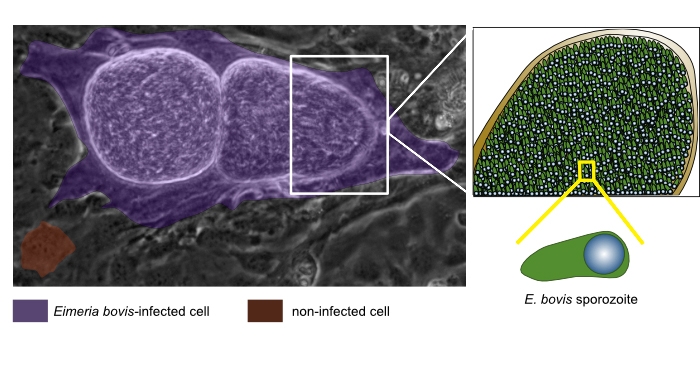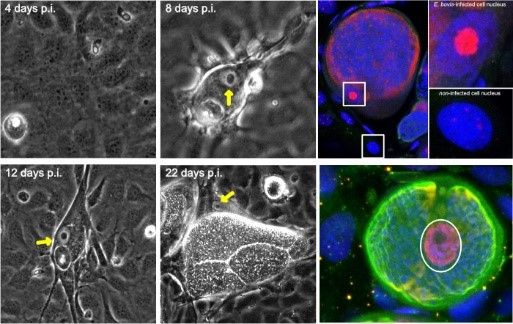Who says aging is always disappointing?
The latest Paper of the Month for Parasitology is “Eimeria bovis infections induce G1 cell cycle arrest and a senescence-like phenotype in endothelial host cells“
Eimeria bovis is a globally spread, host-specific parasite of cattle, causing severe bloody diarrhoea, especially in calves, and therefore high economic losses worldwide. In contrast to most other Eimeria parasites, the infective stages, called sporozoites, must traverse through gut mucosa in order to invade deeper-lying endothelial cells of lymphatic vessels, where they undergo a massive asexual replication (first merogony). Enclosed by a unique membrane [parasitophorous vacuole membrane (PVM)] sporozoites of E. bovis develop into huge macromeronts of up to 300 µm in size within 14–18 days and producing up to 140,000 new parasites (merozoites I) per macromeront (see Fig. 1).

In order to fulfil this impressive replication, the sporozoite virtually hijacks its host cell rendering it firstly into a “defenceless cell” and thereafter influencing the host cell cytoskeleton to overcome a huge size increase. It appears likely that once E. bovis sporozoite begins growth and rapid proliferation, it must also scavenge nutrients from the host endothelial cell. The final enlargement of host cell far beyond its physiological size should cause it considerable stress and also cell death, but this is not the case. Instead, the parasite turns its host cell into an “aging cell status”, known in the literature as senescence. During the process of ‘cell aging’, firstly the parasite modifies the nucleus by changing its morphology and becoming a so-called ‘fried-egg’-like phenotype. This “fried-egg”-like nucleus morphology is the result of intranuclear DNA composition changes (egg white) and the fusion of various nucleoli into one large nucleolus (egg yolk) (please refer to Fig. 2).

Additionally, E. bovis-infected host cells showed enhanced activities of beta-galactosidase, a classical marker for cell aging. Referring to host cell division, this peculiar parasite seems also capable of active inhibit host cell division (G1 cell cycle arrest), which is another advantage if you have to proliferate slowly but massively intracellularly. Overall, these new data indicate that slow replicating E. bovis drives its host cell into an aging (senescence) status in order to achieve its massive offspring production. Furthermore, it reflects the intriguing interaction of this intracellular dwelling parasite with its host endothelial cell when compared to closely related fast replicating parasites such as Toxoplasma gondii, Neospora caninum and Cryptosporidium parvum.
So, coming back to the provocative title…who says aging is always disappointing? At least for sporozoites of E. bovis cell senescence means an additional novel mechanism to profit from host cell nutrients and energy until fulfilling the formation of > 140,000 new offspring parasites without disturbance of cell division!
The paper “Eimeria bovis infections induce G1 cell cycle arrest and a senescence-like phenotype in endothelial host cells“, by Zahady D. Velásquez, Sara López-Osorio, Daniel Waiger, Carolina Manosalva, Learta Pervizaj-Oruqaj, Susanne Herold, Carlos Hermosilla and Anja Taubert, published in Parasitology, is available free for a month.






